Servings: 4
Savory Tang Yuan (鹹湯圓)
This savory tang yuan is a classic dish that Mama Lin makes to celebrate the winter solstice. My mom never measures any of the ingredients, so I’ve streamlined her recipe below. The tang yuan dough is very forgiving. If it’s feeling dry, add a splash of water; if it’s feeling wet, add more flour. That’s exactly how my mom would make the dough.I use a scale to measure my flour and a few other ingredients, and I recommend doing the same if you have one.To make the glutinous rice balls, you must use glutinous rice flour. We typically use Erawan brand’s glutinous rice flour (from Thailand), which comes in see-through plastic bags with a green label. You can find the flour in Asian grocery stores or on Amazon. Do not use regular rice flour, as the rice balls will not turn chewy. If glutinous rice flour is difficult for you to find, you can try using sweet rice flour (such as Mochiko). Note that sweet rice flour/Mochiko tends to be a coarser grind compared to Thai-style glutinous rice flour, so the rice balls won’t be as silky soft.When cooking the daikon, my mom likes to sweeten it with yellow rock sugar, which she purchases in Asian grocery stores (also available on Amazon). Many of you probably don’t have that in your pantry, so you can use granulated or any other type of sugar.
Ingredients
Glutinous Rice Balls
- 2 1/3 cups (250g) glutinous rice flour, use spoon-and-sweep method for volume measurement
- 1 cup (235mL) room temperature water
Daikon
- 1 medium daikon (about 550 to 600 grams), peeled
- 1 1/2 tablespoons oil, any neutral oil like vegetable, sunflower, etc.
- 3 cloves garlic, smashed
- 1/4 cup (15g) dried shrimp, rinsed
- 1 1/4 cups (295mL) water
- 1 small piece of rock sugar (about 8 grams), or 2 teaspoons granulated sugar
- 1/2 teaspoon Diamond Crystal kosher salt, or 1/4 teaspoon sea salt
Fish Cake
- 1 lb (454g) fish paste, from Asian grocery stores (see note 1)
- 3 tablespoons sliced scallions, optional
- oil for pan frying fish cake
Soup
- 2 tablespoons oil, any neutral oil like vegetable, canola, sunflower, etc.
- 1 large shallot, thinly sliced (about 3/4 cup)
- 2 links of Chinese sausages, sliced
- 3 cups (710mL) chicken broth, I used Better Than Bouillon low-sodium soup base
- 1/2 teaspoon Diamond Crystal kosher salt, or 1/4 teaspoon sea salt, plus more to taste
- 3 tablespoons sliced scallions
- 2 tablespoons chopped cilantro
Instructions
Make Glutinous Rice Balls
- Add the glutinous rice flour to a mixing bowl. Pour in 1 cup of water. Stir everything with chopsticks or a wooden spoon, until the water is absorbed into the flour. Gather the dough together with your hands and knead for a minute, until you get a smooth dough. The dough should feel like moist play-doh. If the dough is feeling very wet; add a few teaspoons of flour and knead again. If the dough is feeling dry, add a splash of water.
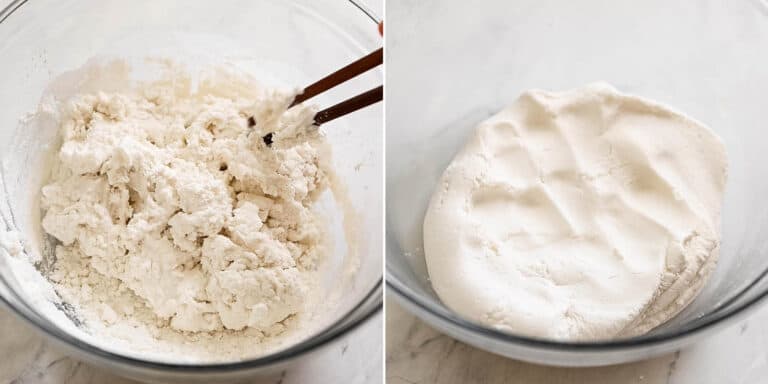
- Rip off about a small handful of flour and shape it into a log that’s about 3/4 to 1-inch thick in diameter. Tear off small pieces of dough that roughly looks like 1 ½ teaspoons per piece. This doesn’t have to be precise.
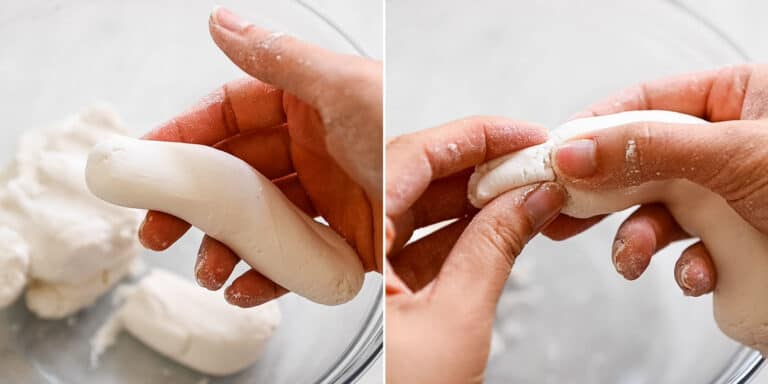
- Roll the small pieces of dough into small balls and transfer them to a large plate. Continue shaping the remaining dough into small rice balls. Set aside while you prepare the other ingredients.
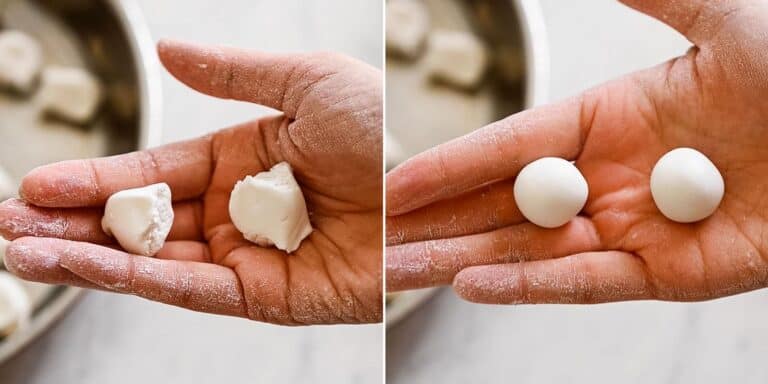
Cook Daikon
- Trim off the green tops from the daikon. Slice the daikon into 1/4 to 1/2-inch thick slices. Then, stack the daikon slices and cut into strips (about 1/4-inch wide).

- Heat a large wok (or pot) with 1 1/2 tablespoons oil over high heat. Add the garlic and fry for about 30 seconds to 1 minute. Add the dried shrimp and cook for another 30 seconds to 1 minute. Next, add the daikon and 1 1/4 cups of water. Add the sugar and cover the wok with a lid and bring the water to a boil. Once boiled, reduce the heat slightly, and let the daikon simmer for 6 to 8 minutes, until tender.
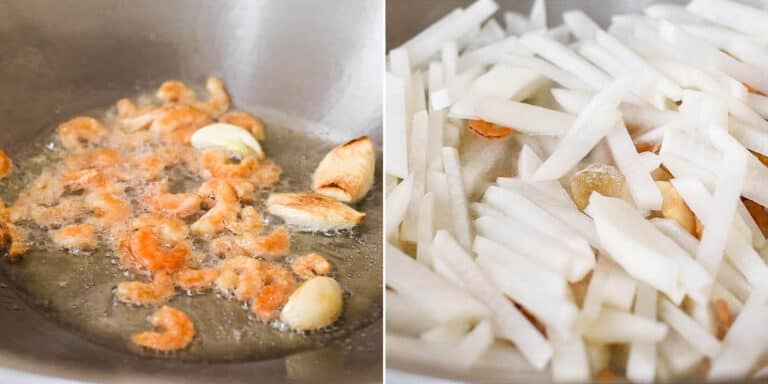
- Uncover the wok and season with salt. (See note 2) Transfer the daikon and all the liquid to a bowl.
Cook Fish Cake
- Sometimes, store-bought fish cake paste can be rather plain. That’s why I like mixing sliced scallions into the fish paste. Feel free to leave out the scallions and skip straight to pan frying the fish cake.
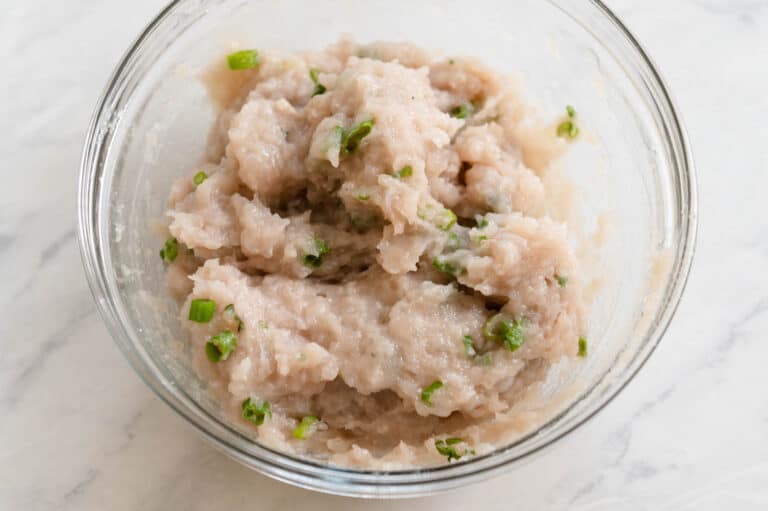
- Brush a layer of oil over the back of a large, flat spatula (something like a wok spatula or a turner spatula). You’ll use the spatula to flatten and shape the fish paste inside the skillet. The oil helps prevent the fish paste from sticking to your spatula.
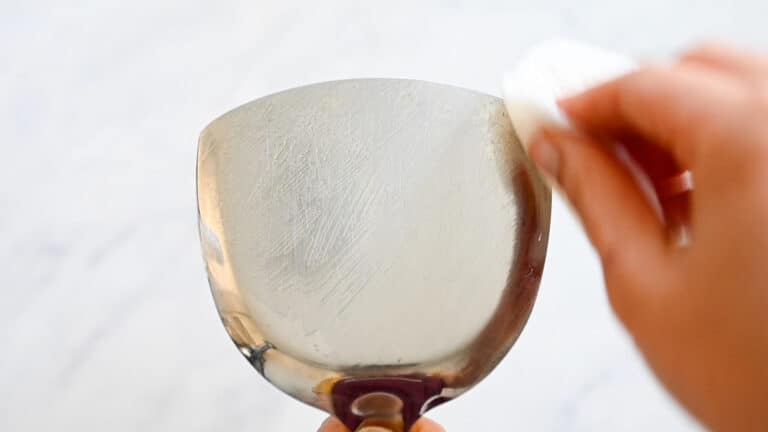
- Coat a large nonstick skillet with a thin layer of oil (about 1 1/2 tablespoons). Heat the pan over medium-high heat and add the fish paste. Then, use the greased spatula to spread and flatten the fish paste into a large cake, about 1/2-inch thick. Pan fry one side for 3 to 4 minutes, until golden. Use a large spatula to flip the fish cake over and pan fry the other side for another 2 minutes. Add a little more oil around the perimeter of the fish cake and tilt the pan around to distribute the oil.
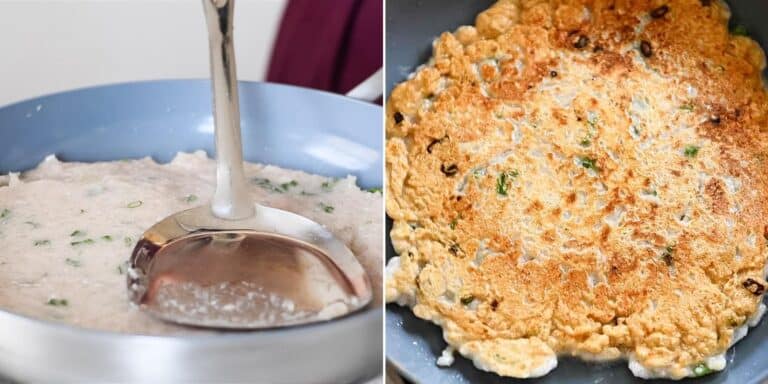
- Transfer the cooked fish cake to a plate and let cool for a few minutes. Then, slice the fish cake into small strips (mine are usually about 1 1/2" x 1/2"). Transfer the sliced fish cakes back to the plate.
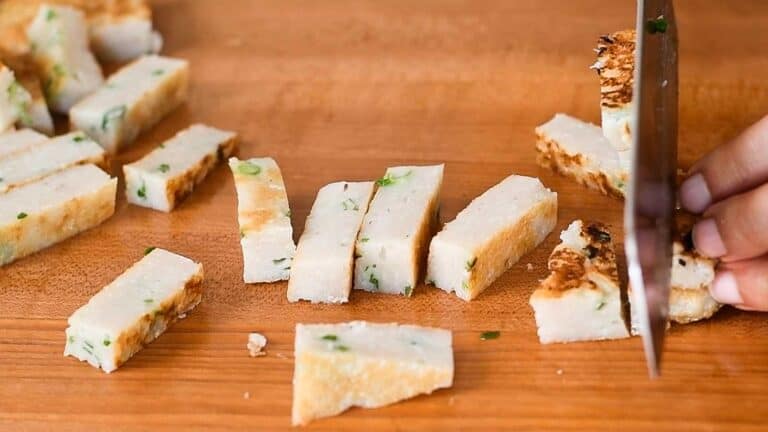
Make Soup
- Heat the wok (or pot) with 2 tablespoons of oil over high heat. Add the sliced shallots and cook for about 1 minute. Add the sliced Chinese sausage and cook for 30 seconds more. Carefully pour in the chicken broth and drain the daikon cooking liquid into the wok. Cover the wok with a lid and bring the liquid to boil.

- Carefully transfer the rice balls into the wok. I usually invert the plate that’s holding the rice balls and use my fingers to gently brush off the balls. Cover the wok with a lid again and cook the rice balls for about 5 minutes. The rice balls should float to the top at this stage.
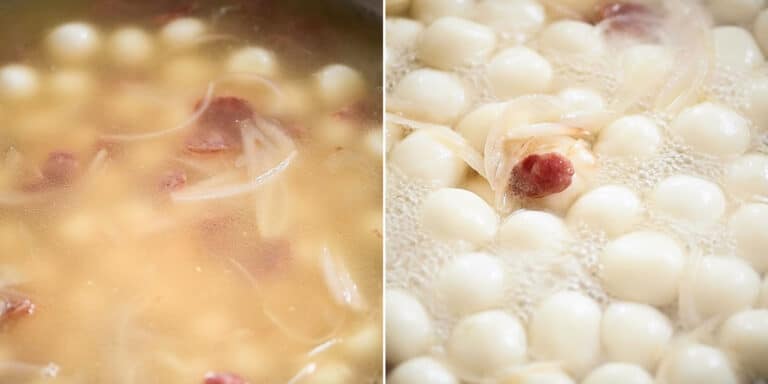
- Season the soup with salt to taste. Add the cooked daikon, shrimp, and fish cake to the wok and toss everything together. Turn off the heat and add the sliced scallions and cilantro and toss again.
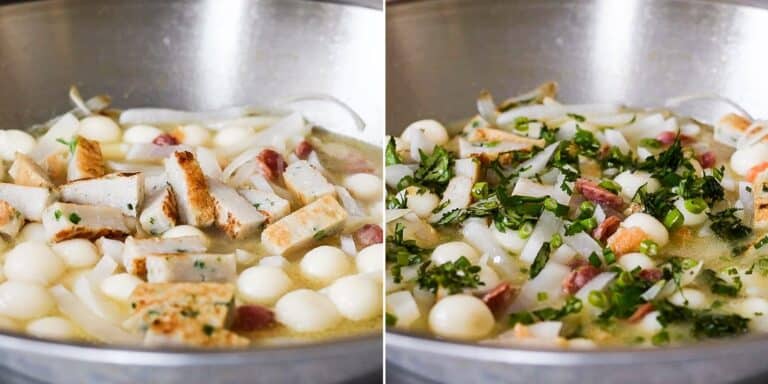
- Serve the tang yuan in bowls with broth. Garnish with more scallions and cilantro, if you like. If you like a slight spicy kick, you can also add a dash of white pepper or chili flakes to the tang yuan.
Notes
- You can find fresh or frozen fish paste in Asian supermarkets. In Sacramento, I’ve been able to find fresh paste at 99 Ranch Market. I like to add scallions to the fish paste to give them extra flavor. If fish paste is difficult to find, you can replace them with fish balls (found in frozen sections of Asian grocery stores) or Japanese-style fried fish cake (also found in Asian grocery stores).
- My mom says that adding the salt too early will cause the daikon to turn slightly bitter.
- Freezing Directions: Line a large plate with a sheet of parchment paper. Then, arrange the uncooked tang yuan over the lined plate, making sure the balls don’t touch each other. Once they harden, transfer the tang yuan to a freezer bag or container. I recommend defrosting the tang yuan before cooking them.
Nutrition
Serving: 1servin | Calories: 639kcal | Carbohydrates: 65.8g | Protein: 36.6g | Fat: 26.2g | Saturated Fat: 4.7g | Cholesterol: 84mg | Sodium: 1281mg | Fiber: 4.8g | Sugar: 7.2g
Did you make this recipe?Tag @hellolisalin or leave a star rating and comment on the blog!
